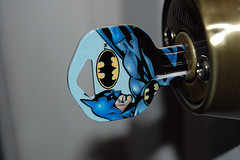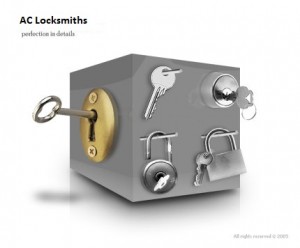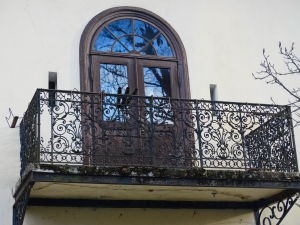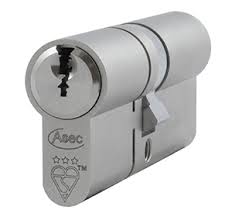This section of Locks Explained looks at the Euro Cylinder:
The Euro cylinder is most commonly used in UPVC double glazed doors with multi-point locking mechanisms. However, some mortice locks have them as well, but the principle is the same. Turning the key in the barrel turns a cam which then operates the locking mechanism in the main body of the mechanism itself. I will do a piece about locking mechanisms in the future, but for now, I am going to concentrate on the cylinder itself.
The first thing I need to draw attention to is the thumb turn – shown here:
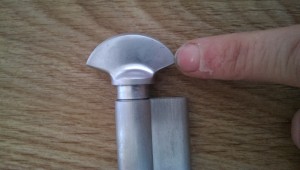
Instead of being operated by a key on the inside, it has this handy part which you can turn to unlock and lock the door.
Very few people have this on their locks, but if you do and your lock does not display a British Standard Kite Mark, be warned, because they are extremely easy to bypass. Without the Kite mark, if this lock is on your outer door it might just as well be left unlocked. I do see them a lot in buildings with secure entrances, but if you are in any doubt, talk to your local locksmith and/or building manager.
Now let’s take a look at a Euro cylinder without the thumb turn, which is the type most of you will have in your double glazed doors:
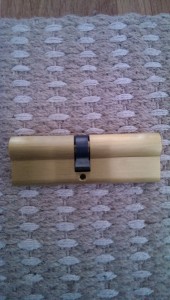
Almost every door that requires you to lift the handles before locking, has one of these going through it.
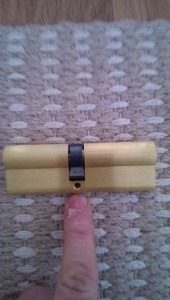
When the cylinder is in place, a screw passes through the mechanism and holds it tight by screwing through this hole.
You may have heard the term ‘cylinder snapping.’ When a burglar uses this method, this is the part that breaks. You can see there is not much metal here holding the whole thing together.
The next part is the cam:
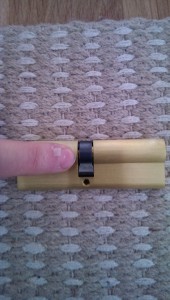
When the key is rotated, it too rotates which you can see here. This picture shows the cam position when the key is out. 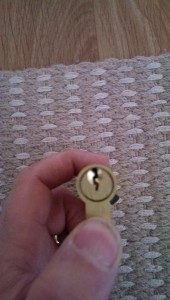
and this one with the key in and part turned;
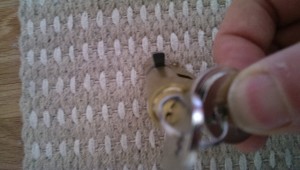 Without going into too much detail, snapping the cylinder allows the burglar to operate the parts of the mechanism which the cam would move, and they can be inside your home in less than a minute without the need for any power tools.
Without going into too much detail, snapping the cylinder allows the burglar to operate the parts of the mechanism which the cam would move, and they can be inside your home in less than a minute without the need for any power tools.
The good news is that there are a few things you can do to stop this. You can have an anti-snapping device fitted inside the handles. You can have new handles that are resistant to attack. But they do not stop traditional lock picking and drilling is still an option for the determined burglar. Also, the insurance company will still pay up when you are burgled because for now at least, most accept these locks as suitable. In fact, if your locks have to be replaced, and these were the ones you had before, they will only pay for like for like replacements leaving you just as vulnerable. Many burglary victims will tell you that once it has happened to you, it will likely happen again.
So what if you don’t want to make that call to the insurance company after the burglary? What can you do to drastically reduce the chances of your home being burgled? Well, firstly, you can go to your local DIY chain and buy a BS3621 kite marked cylinder. These are anti-snap and in many cases will deter the opportunist. However, they can be picked (with patience) and can be bypassed in other ways. It’s a lot harder, but you still might need specialist handles to be really secure.
Or you can opt for the ultimate Euro Cylinder. At the time of writing, and to the best of my knowledge, this is the best cylinder you can have without the need for additional parts;
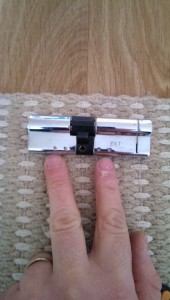
You can see from this picture some studs that run through the bottom. These
hold a reinforced bar aimed at the prevention of cylinder snapping.
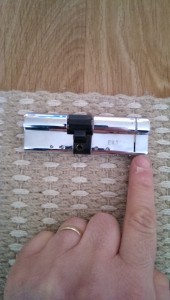
Coupled with this part, which is weakened intentionally so that the front snaps off, rather than the whole thing breaking in the middle. The burglar is not going to easily get to the internal parts of your door.
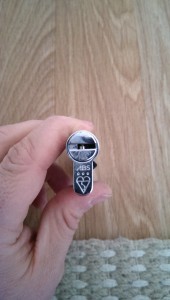
From the front, the lock looks like this;
It is highly recognisable from a distance, meaning the seasoned burglar might not even venture past your front gate because he knows this will be no easy break in. Someone who takes the time to put one of these locks on is probably going to have increased window security as well, so why bother looking when next door’s house looks just as big, has just as nice a car on the drive, but has visibly easier locks to get past? If however he does get close enough to take a good look at the lock, not only will he see that kite mark, but he will also see those three stars. Those stars have a big message. They state that this lock is so good, it doesn’t need the extras. You can make your security three stars with a British Standard lock and some other bits, but this lock does it all in one. I’ve had to bypass one so far. I have specialist equipment and I can tell you it took me a lot more time than a burglar would probably be willing to take and I had to replace a fair few tools afterwards.
So, you can’t snap it, and it is extremely resistant to power tools. What about picking? I’d love to see a TV show where the hero gets out his trusty lock picking set and faces this!
This is the key;
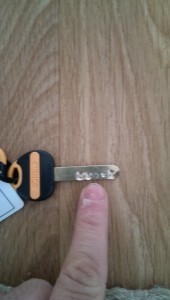
To pick this lock, not only do you have to get these dimples in the right place, you have to get them the right size, because the pins inside the lock are doubled with a pin within a pin. Not only that, but the flat circle you can see is a magnet which can appear anywhere along that key and must tally with the correct magnet position in the lock itself.
For extra security, very few people can cut you new keys for these locks. Only the holder of the key card that comes with the lock can get copies made.
Here is the card;
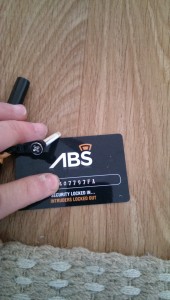
So, you can rest assured no one is going to make copies. Even those few who do cut these keys cannot copy from another key. It must be done from the code on the card. That makes these locks brilliant for landlords of long term tenants and short term holiday lets.
I like these locks so much, they secure my own home.
If you have any questions regarding the above information, please feel free to get in touch via the contacts page.
Thanks for reading



